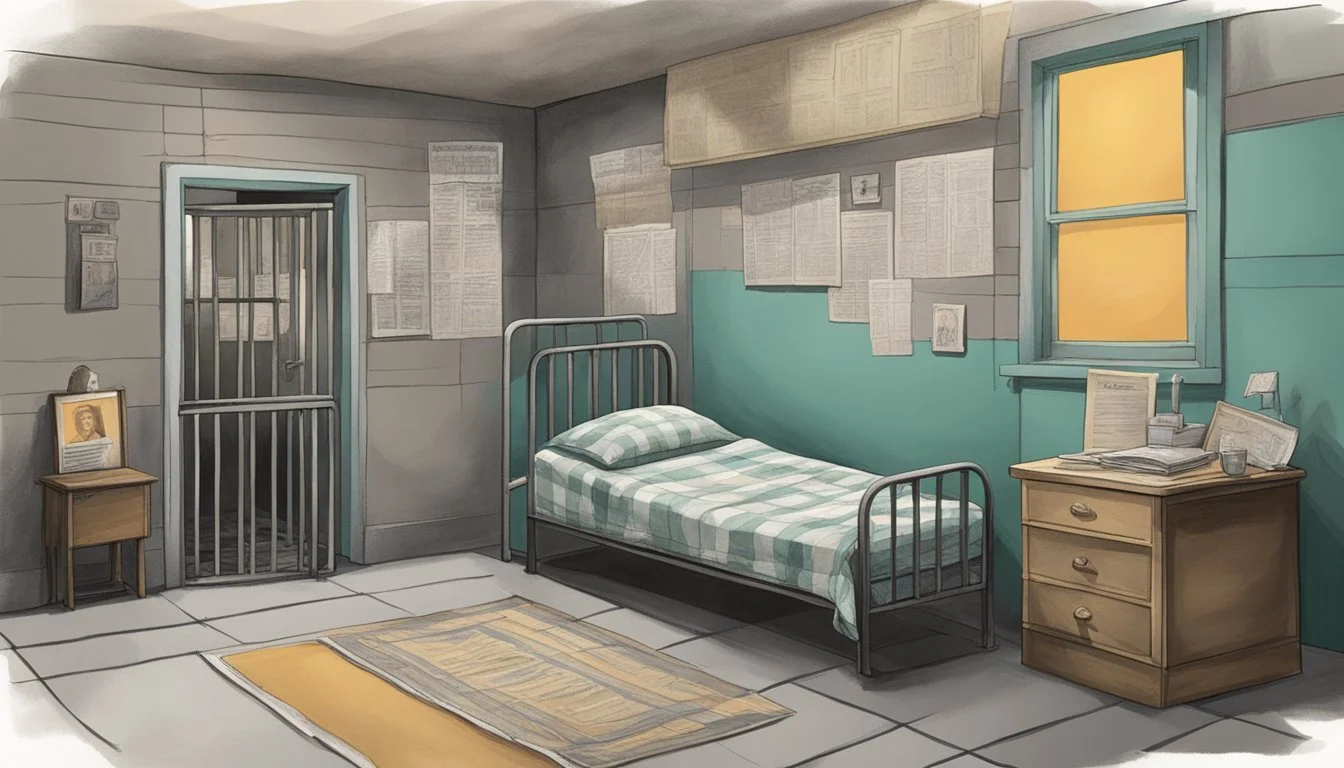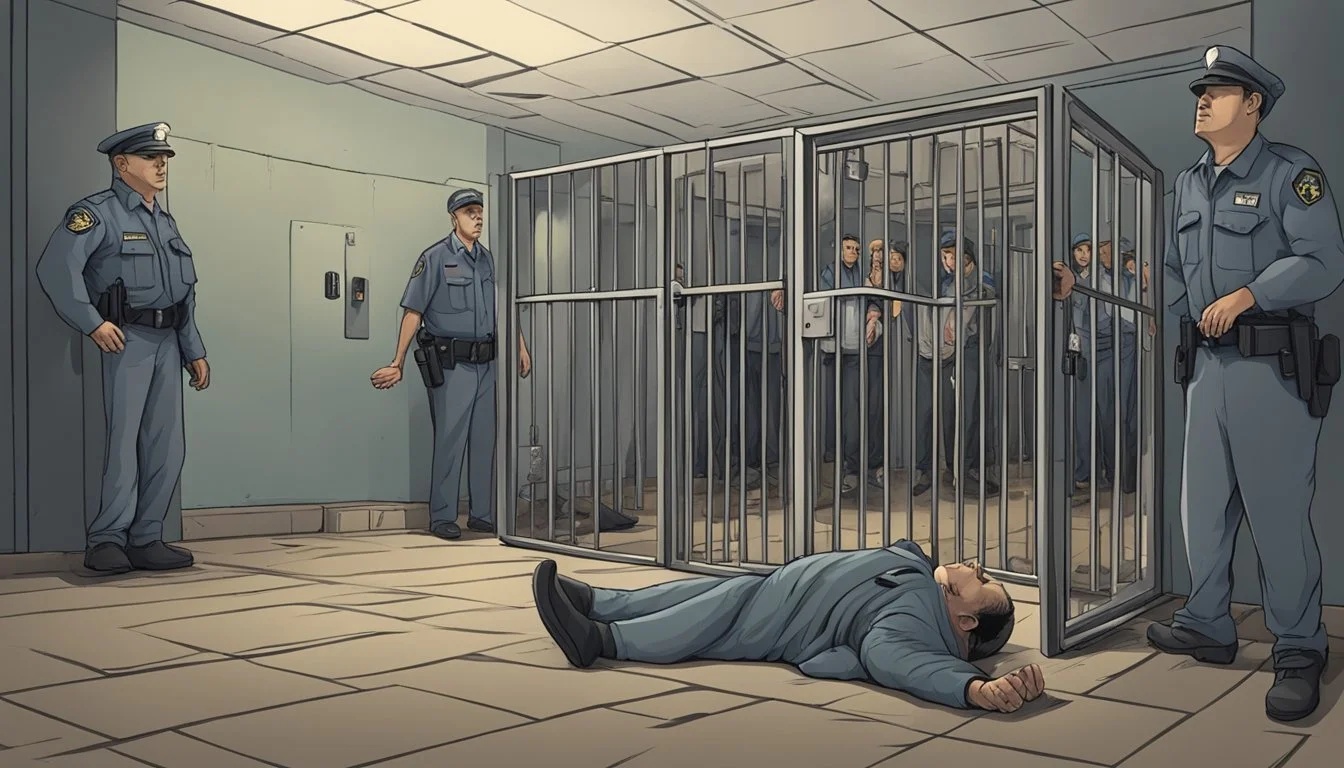Eugene Britt's Grip Loosens: Gary Strangler Dies During Life Sentence
Infamous Serial Killer's Reign of Terror Ends Behind Bars
Eugene Victor Britt, known as the Gary Strangler, has died while serving a life sentence for his heinous crimes. Britt terrorized Gary and Portage, Indiana in 1995, murdering at least seven women and girls during a brutal killing spree. His death marks the end of a dark chapter in Indiana's criminal history, bringing closure to the families of his victims and the communities he traumatized.
Arrested on November 3, 1995, Britt confessed to multiple murders and assaults during police interrogation. His crimes spanned a 1.5-square-mile area in eastern Gary, transforming once-thriving neighborhoods into fearful, emptying streets. The Gary Strangler's violent acts left an indelible mark on the region, sparking a mass exodus of families from affected areas.
Britt's case involved multiple jurisdictions and charges, leading to a complex legal process. Ultimately convicted and sentenced to life imprisonment, he had been incarcerated at Indiana State Prison in Michigan City. While suspected of up to ten murders, Britt's confirmed victims numbered seven, though the full extent of his crimes may never be known.
The Crimes of Eugene Britt
Eugene Britt terrorized Gary, Indiana in 1995, committing a series of brutal murders and assaults. His crimes primarily targeted vulnerable women and girls in a concentrated area of the city.
Timeline of a Killing Spree
Britt's violent rampage began shortly after his release from prison in August 1993. He had previously served half of a 30-year sentence for an earlier crime.
In 1995, Britt's killing spree intensified. He committed multiple murders and assaults within a short period, spreading fear throughout Gary.
The crimes occurred in a 1.5-square-mile area, with Britt targeting victims in specific neighborhoods.
Victims and Their Stories
Britt's victims were primarily women and girls. One of his most shocking crimes was the rape of an 8-year-old girl from Portage, Indiana.
Betty Askey, a 50-year-old woman, was among those murdered by Britt. Her story highlights the indiscriminate nature of his attacks.
Britt's victims came from various backgrounds, but many were vulnerable individuals in the Gary area.
Key Locations: Gary and Glen Park
Gary, Indiana served as the primary backdrop for Britt's crimes. The city's economic decline and high crime rates provided an environment where Britt could operate.
The 13th Avenue neighborhood in eastern Gary fell within Britt's hunting ground. Once a bustling residential area, it experienced rapid decline following his crimes.
Glen Park, a neighborhood in Gary, was another key location in Britt's spree. The area's layout and demographics made it vulnerable to his attacks.
Capture and Investigation
Eugene Britt's reign of terror in Gary, Indiana came to an end in November 1995. His arrest marked the beginning of a complex legal process involving multiple jurisdictions and charges.
The Breakthrough
Gary police arrested Eugene Britt on November 3, 1995. The breakthrough came after an intensive investigation into a series of murders and assaults in the area.
Law enforcement had been tracking a pattern of crimes against vulnerable women and girls within a 1.5-square-mile zone. Forensic evidence and witness statements eventually led detectives to Britt.
The arrest sent shockwaves through the community, particularly in neighborhoods like 13th Avenue where Britt had operated.
Eugene Britt's Interrogation
During interrogation, Britt confessed to multiple murders and assaults. His statements provided crucial details about unsolved cases.
Investigators were able to link Britt to several crime scenes based on his confessions. He described his methods and revealed locations of victims' remains.
The interrogation process was lengthy and complex. Detectives had to carefully corroborate Britt's statements with existing evidence.
Police and Law Enforcement's Role
Gary Police Department led the investigation, working closely with other agencies. Their efforts involved extensive forensic analysis and witness interviews.
Detectives meticulously pieced together evidence from multiple crime scenes. They faced challenges due to the wide geographic spread of Britt's crimes.
Law enforcement's thorough work resulted in a strong case against Britt. In February 2000, after further investigation, Britt was charged with six additional murders and the rape of a 13-year-old girl.
The police's dedication brought closure to many families and helped secure Britt's conviction.
Legal Proceedings
Eugene Britt's legal journey involved a complex trial, a shocking confession, and a lengthy sentencing process. His case highlighted the intricacies of prosecuting serial killers across multiple jurisdictions.
The Trial and Confession
Eugene Britt's trial began in 1996 after his arrest in November 1995. During police interrogation, Britt confessed to multiple murders and assaults, providing detailed accounts of his crimes.
The prosecution presented a strong case, bolstered by Britt's own admissions. DNA evidence linked him to several crime scenes, further strengthening the case against him.
Britt's defense team faced significant challenges due to the overwhelming evidence and their client's confessions. They focused on mitigating factors, including Britt's troubled background and mental health issues.
Verdict and Sentencing
The jury found Eugene Britt guilty on all charges. His crimes spanned multiple jurisdictions in Indiana, including Gary and Portage.
The judge sentenced Britt to 245 years in prison, effectively ensuring he would spend the rest of his life behind bars. The sentence reflected the severity and number of his crimes.
Prosecutors did not pursue the death penalty, opting instead for the lengthy prison term. This decision spared the victims' families from prolonged appeals typically associated with capital cases.
Appeals and Legal Representation
Despite the overwhelming evidence, Britt's legal team filed several appeals. They challenged aspects of the investigation and trial proceedings.
These appeals were largely unsuccessful, with higher courts upholding the original verdict and sentence. Britt's confessions and the physical evidence proved difficult to overcome.
Throughout the appeals process, Britt was represented by court-appointed attorneys. They argued for reduced sentences and retrials, citing procedural issues and claiming inadequate representation during the initial trial.
Victimology and Impact on Families
Eugene Britt targeted vulnerable individuals in Gary and Portage, Indiana. His crimes devastated families and communities, leaving lasting scars on those affected by his actions.
Understanding Britt's Targets
Britt primarily focused on vulnerable women and girls in economically disadvantaged areas. His victims included 8-year-old Sarah Lynn Paulsen and adult women like Tonya Dunlap. Many lived in struggling neighborhoods with high crime rates.
Britt exploited their vulnerability, often attacking in isolated areas or during times when victims were alone. He targeted those he perceived as less likely to be missed or quickly reported missing.
Some victims were sex workers or individuals battling addiction, further complicating initial investigations. Britt's choice of targets reflected a calculated approach to avoid detection and prolong his crime spree.
The Aftermath for Victims' Families
The impact on victims' families was profound and long-lasting. Many experienced intense grief, anger, and trauma following the loss of their loved ones. Some families struggled with guilt, wondering if they could have done more to protect their relatives.
The protracted nature of Britt's crimes and subsequent legal proceedings prolonged the suffering for many. Families endured years of uncertainty and painful court appearances.
Support groups formed in affected communities, providing a space for shared healing. However, the emotional toll remained significant. Some families reported difficulty trusting others or feeling safe in their own neighborhoods.
The case highlighted the need for improved support systems for victims' families in the aftermath of violent crimes. It also sparked discussions about community safety and the importance of protecting vulnerable populations.
Profile of a Serial Killer
Eugene Britt's criminal history reveals a disturbing pattern of violence and predatory behavior. His actions and background provide insights into the complex factors that may contribute to serial killers' development.
Eugene Britt's Background
Eugene Victor Britt was born on November 4, 1957. He grew up in Gary, Indiana, a city that would later become the primary location of his crimes. Britt's early life was marked by intellectual disabilities and mental health issues.
These challenges likely played a role in shaping his future criminal behavior. Despite his struggles, Britt managed to blend into society for years before his crimes came to light.
In 1995, Britt's killing spree began, targeting vulnerable women and girls in Gary and Portage, Indiana. His victims ranged from 8 to 51 years old.
Psychological and Criminological Insights
Britt's case presents a complex profile for criminologists and psychologists. His intellectual disabilities and potential mental illness likely contributed to his violent tendencies.
Experts suggest that such factors, combined with possible childhood trauma or environmental influences, can sometimes lead to the development of serial killers.
Britt's modus operandi involved rape and strangulation, common among serial killers who seek power and control over their victims. His choice of vulnerable targets in familiar areas aligns with typical predatory behavior.
The duration of Britt's crime spree - from May to September 1995 - indicates an escalation in his criminal activities. This pattern is often observed in serial killers as they become more confident and compulsive in their actions.
Public Reaction and Media Coverage
Eugene Britt's crimes shocked the community of Gary, Indiana and drew intense media scrutiny. The case highlighted issues of public safety and sparked debates about law enforcement's handling of serial killers.
Media's Role in the Case
Local and national news outlets extensively covered Eugene Britt's arrest and trial. Newspapers like the Chicago Tribune ran front-page stories detailing the crimes and investigation. Television news programs featured interviews with law enforcement officials and victims' families.
The media's portrayal of Britt as the "Gary Strangler" fueled public fear and fascination. Some critics argued that the sensationalized coverage glorified the killer. Others praised journalists for raising awareness about the case and pushing for accountability.
Community Response to the Tragedy
Gary residents reacted with horror and grief as Britt's crimes came to light. Many expressed anger at local authorities for not catching the killer sooner. Community leaders like Rev. Clyde Smith organized prayer vigils and support groups for victims' families.
The murders led to increased neighborhood watch programs and self-defense classes. Some residents moved away, fearing for their safety. Others worked to reclaim their streets through community policing initiatives.
Local officials faced pressure to improve public safety measures. The police department implemented new protocols for investigating potential serial killings.
Societal and Cultural Context
Eugene Britt's crimes occurred against a backdrop of economic decline and rising crime in Gary, Indiana. The city faced significant challenges that shaped the environment in which these murders took place.
Gary's Economic Struggles and Crime Rates
Gary, Indiana experienced severe economic hardship in the 1990s. The city's population declined sharply, dropping from 116,646 in 1990 to 102,746 in 2000. This 12% decrease reflected the ongoing industrial decline.
U.S. Steel, Gary's largest employer, drastically reduced its workforce. Thousands of jobs disappeared, leaving many residents unemployed. Poverty rates climbed, reaching 25.8% by 2000.
As economic conditions worsened, crime rates soared. In 1995, the year of Britt's killing spree, Gary's murder rate was 132 per 100,000 residents. This was nearly 20 times the national average.
Criminal Cases Impact on Gary's Reputation
High-profile criminal cases like Eugene Britt's further damaged Gary's reputation. National media coverage of the "Gary Strangler" reinforced perceptions of the city as dangerous and crime-ridden.
Local businesses struggled to attract customers. Tourism declined. Property values plummeted in affected neighborhoods. Some residents left the city, fearing for their safety.
The crimes highlighted issues of gang violence and drug trafficking. Law enforcement faced criticism for their handling of the case. Community trust in local institutions eroded.
Gary's attempts at economic revitalization were hampered by its negative image. Potential investors and new residents were deterred by the city's association with violent crime.
Legacy of the Case
Eugene Britt's crimes left an indelible mark on Gary, Indiana and the surrounding areas. His actions prompted significant changes in law enforcement practices and sparked conversations about rehabilitation and redemption.
Institutional Changes in Law Enforcement
The Gary Strangler case exposed vulnerabilities in local policing methods. Law enforcement agencies implemented new protocols for handling serial crime investigations. These included improved evidence collection techniques and enhanced communication between jurisdictions.
Police departments increased patrols in high-risk areas and established community outreach programs. The goal was to build trust and encourage residents to report suspicious activities promptly.
Training programs for officers were updated to include specialized courses on profiling serial offenders. This aimed to improve early detection and prevention of similar crimes in the future.
Reflection and Redemption
During his incarceration, Eugene Britt expressed remorse for his actions. He participated in prison counseling programs and sought to understand the root causes of his behavior.
Some victims' families found solace in Britt's apparent transformation. Others remained skeptical, viewing his expressions of regret as insincere.
Britt's case sparked debates about the possibility of redemption for violent offenders. It raised questions about the effectiveness of rehabilitation programs in prisons.
Criminal justice experts studied Britt's case to gain insights into the psychology of serial killers. Their findings contributed to ongoing efforts in crime prevention and offender rehabilitation.








